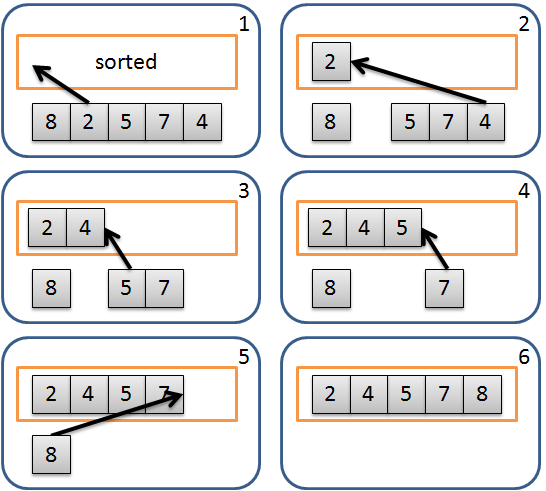簡介 氣泡排序法 (Bubble Sort) 是最容易理解和實作的一種排序演算法 ,也翻譯作冒泡排序法。由於它很容易學習,所以也是許多演算法課程中第一個學習的排序演算法。
由於他的演算法過程會將最大的數值移動到陣列最後面,而較小的數值則逐漸的往陣列前端移動,就像有許多氣泡慢慢從底部浮出,因此稱為氣泡排序法。他的運作流程如下:
比較相鄰的兩個元素,若前面的元素較大就進行交換。 重複進行 1 的動作直到最後面,最後一個元素將會是最大值。 重複進行 1, 2 的動作,每次比較到上一輪的最後一個元素。 重複進行以上動作直到沒有元素需要比較。 流程示意圖:
實作上直接使用迴圈就可以很容易的完成。另外可以使用額外的旗標 (Flag) 來判斷這一輪是否有發生交換情形,若都沒有發生交換表示數列已經是排序好的,即可跳出迴圈,因此最佳時間複雜度是有可能達到 O(n)。
分析 最佳時間複雜度:O(n) 平均時間複雜度:O(n^2) 最差時間複雜度:O(n^2) 空間複雜度:O(1) Stable sort:是 虛擬碼 一般版本 1 2 3 4 5 6 7 8 9 10 11 function sort(list) // 重複 N 次 for i = 0 to list.length - 1 // 比較到上一輪最後一個 for j = 0 to list.length - i - 1 if list[j] > list[j+1] swap (list[j], list[j+1]) end if end for end for end function
旗標版本 1 2 3 4 5 6 7 8 9 10 11 12 13 14 15 16 function sort(list) // 重複N次 for i = 0 to list.length - 1 var swapped = false //比較到上一輪最後一個 for j = 0 to list.length - i - 1 if list[j] > list[j+1] swap (list[j], list[j+1]) swapped = true end if end for if !swapped break end if end for end function
語法 C# 一般版本 1 2 3 4 5 6 7 8 9 10 11 12 13 14 15 16 17 18 19 20 21 22 23 24 25 using System;using System.Collections.Generic;using System.Linq;using System.Text;namespace BubbleSort { class BubbleSort { public static void Sort (int [] array { for (int i = array.Length - 1 ; i > 0 ; --i) for (int j = 0 ; j < i; ++j) if (array[j] > array[j + 1 ]) Swap(array, j, j + 1 ); } private static void Swap (int [] array, int indexA, int indexB { int tmp = array[indexA]; array[indexA] = array[indexB]; array[indexB] = tmp; } } }
旗標版本 1 2 3 4 5 6 7 8 9 10 11 12 13 14 15 16 17 18 19 20 21 22 23 24 25 26 27 28 29 30 31 32 33 using System;using System.Collections.Generic;using System.Linq;using System.Text;namespace BubbleSort { class FlagBubbleSort { public static void Sort (int [] array { for (int i = array.Length - 1 ; i > 0 ; --i) { bool swapped = false ; for (int j = 0 ; j < i; ++j) if (array[j] > array[j + 1 ]) { Swap(array, j, j + 1 ); swapped = true ; } if (!swapped) break ; } } private static void Swap (int [] array, int indexA, int indexB { int tmp = array[indexA]; array[indexA] = array[indexB]; array[indexB] = tmp; } } }
Java 一般版本 1 2 3 4 5 6 7 8 9 10 11 12 13 14 15 16 public class BubbleSort { public static void Sort (int [] array) { for (int i = array.length - 1 ; i > 0 ; --i) for (int j = 0 ; j < i; ++j) if (array[j] > array[j + 1 ]) Swap(array, j, j + 1 ); } private static void Swap (int [] array, int indexA, int indexB) { int tmp = array[indexA]; array[indexA] = array[indexB]; array[indexB] = tmp; } }
旗標版本 1 2 3 4 5 6 7 8 9 10 11 12 13 14 15 16 17 18 19 20 21 22 23 24 public class FlagBubbleSort { public static void Sort (int [] array) { for (int i = array.length - 1 ; i > 0 ; --i) { boolean swapped = false ; for (int j = 0 ; j < i; ++j) if (array[j] > array[j + 1 ]) { Swap(array, j, j + 1 ); swapped = true ; } if (!swapped) break ; } } private static void Swap (int [] array, int indexA, int indexB) { int tmp = array[indexA]; array[indexA] = array[indexB]; array[indexB] = tmp; } }
C++ 一般版本 BubbleSort.h
1 2 3 4 5 6 7 8 9 10 11 12 13 14 15 16 #ifndef BUBBLESORT_H #define BUBBLESORT_H #include <algorithm> using namespace std;class BubbleSort { public : static void Sort (int * array, int length) protected : private : }; #endif
BubbleSort.cpp
1 2 3 4 5 6 7 8 9 #include "BubbleSort.h" void BubbleSort::Sort (int * array, int length) for (int i = length - 1 ; i > 0 ; --i) for (int j = 0 ; j < i; ++j) if (array[j] > array[j + 1 ]) swap (array[j], array[j + 1 ]); }
旗標版本 FlagBubbleSort.h
1 2 3 4 5 6 7 8 9 10 11 12 13 14 15 16 #ifndef FLAGBUBBLESORT_H #define FLAGBUBBLESORT_H #include <algorithm> using namespace std;class FlagBubbleSort { public : static void Sort (int * array, int length) protected : private : }; #endif
FlagBubbleSort.cpp
1 2 3 4 5 6 7 8 9 10 11 12 13 14 15 16 17 #include "FlagBubbleSort.h" void FlagBubbleSort::Sort (int * array, int length) for (int i = length - 1 ; i > 0 ; --i) { bool swapped = false ; for (int j = 0 ; j < i; ++j) if (array[j] > array[j + 1 ]) { swap (array[j], array[j + 1 ]); swapped = true ; } if (!swapped) break ; } }
延伸閱讀 排序演算法 (Sorting)







